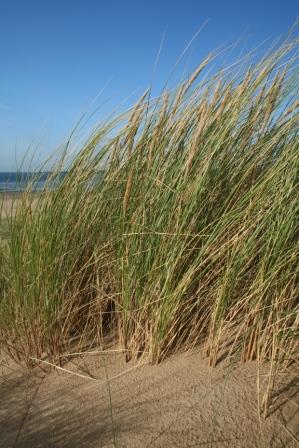 SUCCESSION = a directional change in a community of organisms over time
SUCCESSION = a directional change in a community of organisms over timeSuccession is a change in the structure and species composition of a community, which occurs because of the canges caused by the preseence of established organisms, or by external influence.
PRIMARY SUCCESSION occurs in an area where there is no soil or living organisms so in areas like sand dunes (which display of seres of succession in the same place!), on top of landslides, lava flows or depositional features like moraines left my retreating glaceirs (I am going to move on before I start talking Geography!!!) - so basically any bare land that has nothing growing or living on it!
PIONEER SPECIES are the first to colonise. They:
 - are able to tolerate extreme conditions, primarily the very poor nutriential value of the soils, and high salinity
- are able to tolerate extreme conditions, primarily the very poor nutriential value of the soils, and high salinity- very good at dispersing their seeds to grow; through aeolian transport normally
- are not influenced by or dependent upon animal species
 This can basically be summarised to: they can tolerate harsh abiotic conditions. There death is crucial to succession though as their death provides organic material (known as HUMUS) which can hold water and provide nutrients for the next plants.
This can basically be summarised to: they can tolerate harsh abiotic conditions. There death is crucial to succession though as their death provides organic material (known as HUMUS) which can hold water and provide nutrients for the next plants.STABILISING SPECIES (e.g marram grass), stabilises sand dunes, for example, using their roots and underground stems. Humus and nutrients accumulates, improving the conditions even more for the next stage.
Legumes eventually colonise and these are crucial as they play a key role in nirtogen fixation which enables larger plants to succeed the smaller ones.
The final stable community is called the CLIMAX COMMUNITY, which in the UK is deciduous woodland. Climax community species:
 - have large seeds so that the seedling can tolerate low light intensity
- have large seeds so that the seedling can tolerate low light intensity- have a specialised niche
- unable to tolerate great fluctuations in soil water content, hence why it is so important that humus accumulates before this stage can be reached
- are strongly influenced by other organisms
DEFLECTED SUCCESSION is holding succession at a particular point (e.g mowing or cutting vegetation back) which prevents the climax community from being formed.
So, I think we need to know an example and the one we got taught was the process of succession when a glacier melts and leaves behind moraines:
- nitrogen concentration increases as legumes perfomr nitrogen fixation
- spruce trees absorb nitrogen
- pioneer plants improve soil conditions
- spruce tress outcompete the smaller plants
- more spruce trees and more alder (the climax communtiy) increase the biomass
When an established community is destroyed a new community will eventually develop and secondary succession will take place.
SECONDARY SUCCESSION occurs where an existing community has been cleared by a distrubance (more geography references here! Disturbances are often natural disasters like floods, volcanic activity etc. although human activity can have a similar effect)
No comments:
Post a Comment